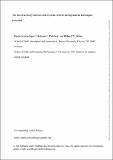The fate of accessory minerals and key trace elements during anatexis and magma extraction
Date
19/02/2020Metadata
Show full item recordAbstract
Granite genesis and crustal evolution are closely associated with partial melting in the lower or middle crust and extraction of granite magmas to upper levels. This is generally thought to be the leading mechanism by which the upper continental crust became enriched in incompatible components such as the heat-producing elements U and Th through time. However, field evidence from anatectic terrains, the source rocks of granite magmas, raises doubt about the efficiency of this process. Leucosomes and associated leucogranites, representative of melts in such terrains, are often depleted in U, Th and REE compared to their source and therefore unable to enrich the upper crust in these elements. This paper demonstrates using anatectic turbidites exposed on Kangaroo Island that accessory minerals, the main host of U, Th and REE, become preferentially concentrated in the melanosomes, effectively removing these elements from the melt. Whole rock geochemistry and detailed petrography suggests that (a) peraluminous melts dissolve only small fractions of monazite and xenotime, because efficient apatite dissolution saturates melt early in phosphorous; and (b) local melt–host reaction emerging from melt migration may cause substantial melt to crystallize in the magma extraction channelways in or close to the magma source region. Crystallization causes oversaturation of the magma triggering the crystallization and capture of accessory minerals in the growing biotite-rich selvedge rather than in the melt channel itself. Crystallization of accessory minerals away from the leucosomes explains the apparent under-saturation of elements hosted by these accessory minerals in the leucosome. While intense reworking of thick piles of turbidites, common in accretionary orogens, reflect important processes of crustal formation, the fate of accessory phases and the key elements they control, such as the heat producing elements U and Th, is strongly dependent on the interaction between melt and surrounding solids during segregation and extraction.
Citation
Schwindinger , M , Weinberg , R & White , R W 2020 , ' The fate of accessory minerals and key trace elements during anatexis and magma extraction ' , Journal of Petrology , vol. 61 , no. 2 , egaa031 . https://doi.org/10.1093/petrology/egaa031
Publication
Journal of Petrology
Status
Peer reviewed
ISSN
0022-3530Type
Journal article
Description
This work was financially supported by ARC grant DP110102543.Collections
Items in the St Andrews Research Repository are protected by copyright, with all rights reserved, unless otherwise indicated.

